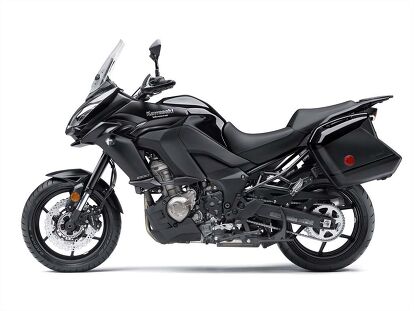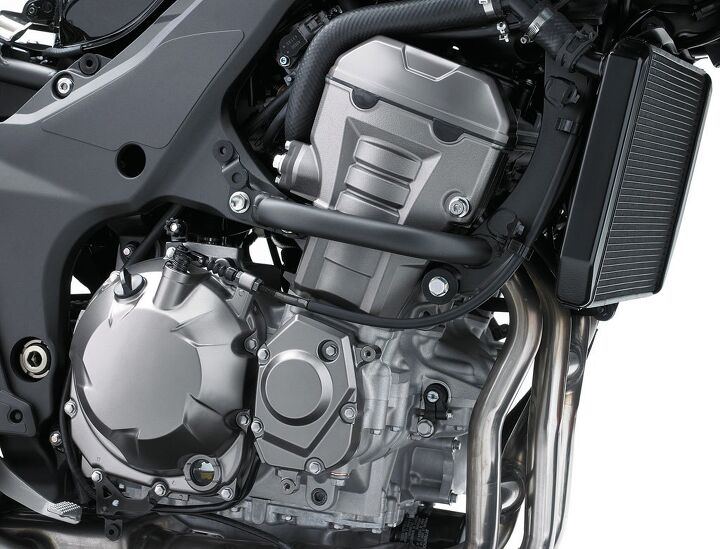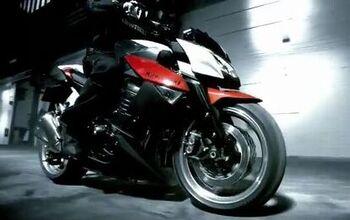2015 Kawasaki Versys 1000 LT Preview + Video
New and Improved, the Big Versys is on its way to North America
Everybody loved the little Versys 650; Kawasaki hopes they’ll love the new Versys 1000 LT that much more. Initial impressions are that we probably will.
About the only thing some people find to complain about with Kawasaki’s excellent Ninja 1000 is handlebar vibration: The new big Versys houses the same 1043cc inline Four-cylinder in a very similar frame, but in rubber mounts, while its sit-up-straight tapered handlebar is also rubber isolated.
Okay, well not quite the same engine. Kawasaki tells us the Versys version is “tuned for more midrange,” though it uses the same 38mm throttle bodies as the Ninja. Three-mode traction control (KTRC) should make it safer to harness: Two of those are for sporty pavement riding, and one is for “negotiating slippery surfaces with confidence.” Three engine power modes let you reduce output for slick conditions, and ABS will also be standard equipment. A slipper clutch also assists with rapid decel, while reducing lever effort.
The new bike seems to pay homage to the Bologna school of adventure-bike styling without straying too far from Kawasaki’s insectivore roots. Anyway, the new side-by-side headlights and intake mouth below them are a vast improvement to most Western eyes over the previous Versys 1000, which never was imported to the U.S. Kawasaki says the chin spoiler contributes downforce at higher speeds to enhance stability, and the air intake between the headlights force-feeds the airbox at speed. Channels on either side of the front fairing, between the upper and side sections, are claimed to smooth airflow and reduce drag.
In many other ways, the new big Versys resembles an “adventure” version of the Ninja 1000, including its superb standard KQR (Kawasaki Quik Release) hard bags and 17-inch wheels at either end. Longer-travel suspension (5.9 inches at both ends), including an inverted fork with 43mm tubes (instead of 41mm for the Ninja), raise the comfy seat from 32.3 inches (Ninja) to 33.1 on the Versys, but Kawasaki says not to worry as the seat is narrow up front for ease of groundification, and the taller seat allows lower footpegs for increased all-day riding comfort.
In fact, comfortable all-day cruising seems to be the theme. A big, height-adjustable windshield with three-inches of tool-free vertical adjustment and standard handguards fend off the elements (heated grips are one of many options), and the same rails that mount the excellent bags serve as passenger grabrails, on a bike that looks like it should be not bad at all two-up. Five-and-a-half-gallon fuel capacity should give 200-mile range easily, especially if you keep the little ECO lamp lit. The 28-liter saddlebags are standard issue, but an optional KQR 47-liter Top Case is large enough to store two full-face helmets. Like the saddlebags, it is color-matched to the Versys bodywork and keyed to use the ignition key. The alternator supplies 15.3 amps at just 1100 rpm, which should be enough to run various accessories.
A standard centerstand is another great standard feature for riders who like to pile on the miles and leave a little chain lube in the motel parking lot.
To compete in the U.S. market in this very popular class, the new Versys 1000 will have to be priced similarly to the Suzuki V-Strom 1000, which in Adventure form (panniers, handguards, engine guards, etc.) sells for $13,999. The Versys 1000 LT will be available in Candy Burnt Orange / Metallic Spark Black and Flat Ebony / Metallic Spark Black color schemes, as early as November, ie. next month. Stand by for further details.
2015 Kawasaki Versys 1000 LT Specifications | |
|---|---|
| Engine | Four-stroke, liquid-cooled, DOHC, four valves per cylinder, inline-four |
| Displacement | 1,043cc |
| Bore x stroke | 77 x 56mm |
| Compression ratio | 10.3:1 |
| Maximum torque | 75.2 lb-ft @ 7500 rpm |
| Cooling | Liquid |
| Fuel Injection | DFI® with four 38mm Keihin throttle bodies, oval sub-throttles |
| Ignition | TCBI with digital advance |
| Transmission | Six-speed |
| Final drive | Sealed chain |
| Frame | Twin-spar aluminum |
| Front suspension | KYB 43mm inverted front fork with adjustable rebound and preload / 5.9” travel |
| Rear suspension | Horizontal back-link shock with adjustable rebound damping and adjustable spring preload, remote preload adjuster / 5.9” travel |
| Front tire | 120/70×17 |
| Rear tire | 180/55×17 |
| Front brakes | Dual 310mm petal rotors with four-piston calipers, ABS |
| Rear brakes | Single 250mm petal rotor with single-piston caliper, ABS |
| Overall length | 88.2” |
| Overall width | 35.2” |
| Overall height | 55.1” (windshield set low), 57.7” (windshield set high) |
| Ground clearance | 5.9” |
| Seat height | 33.1” |
| Wheelbase | 59.8” |
| Curb weight | 549 lb |
| Fuel capacity | 5.5 gallons |
| Colors | Candy Burnt Orange / Metallic Spark BlackFlat Ebony / Metallic Spark Black |
| MSRP Standard | $12,799 |
| Warranty | 12 months |
| Kawasaki Protection Plus (optional) | 12, 24, 36 or 48 months |
More by John Burns







































Comments
Join the conversation
I certainly hope Kawasaki undercuts Suzuki's V-Strom 1000 Adventure by a decent amount. I see no reason why cross-shopping between sport-tourers and asphalt-only "adventure" bikes would not be permissible as they're used for the same purpose and have almost the same riding triangle; it's not like I would compare it to a cruiser. With that, I'll take the liberty to point out the FJR1300 is $15,890.
Now I'm sure an 88lb lighter Versys 1000 LT would be more fun to ride than the FJR, but for me—and perhaps for many people—to truly lust for a bike, it must satisfy both hemispheres of my brain. With that, the FJR's value proposition is too hard to ignore; shaft-drive, cruise control, electronic windscreen, and a few other accouterments make the $1891 difference seem well worth it. Furthermore, the current fair-market value for new (2013 & 2014) FJR1300s is about $12k as per a 400 mile radius search on Cycletrader right now. So finally, for the Versys 1000 LT to legitimately be a contender for my next bike at the beginning of next season, I would have to be able to grab one for under $10k.
On that note, I'm hoping an FJ-09 "LT" might be available for about that much.
If you can give up about a second in the quarter mile and $ave a bundle and get better gas mileage, consider the 2015 650 Versys with ABS. I'm hoping Yamaha will being a FJ-07 adventure bike to market as well. That F-07 is a blast to ride!